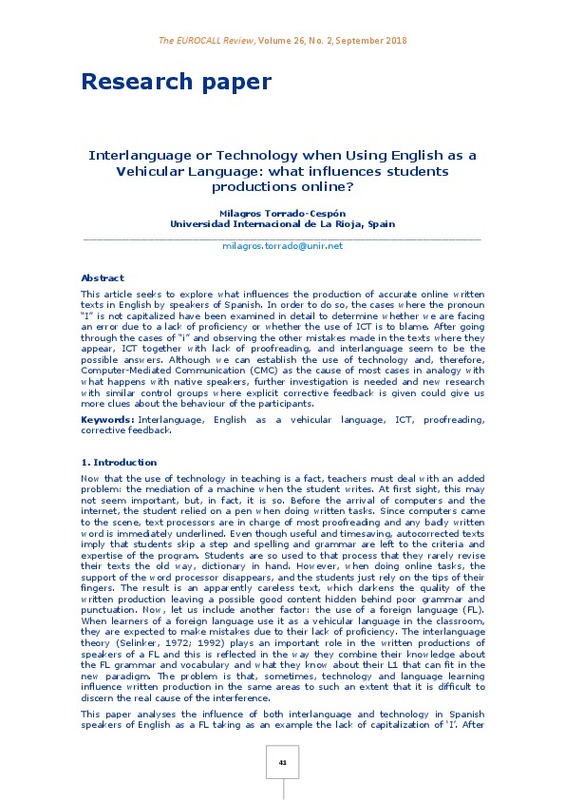Ask.metafilter.com. (2017). Why do so many people always use lower case letters when using the net? Available from http://ask.metafilter.com/43656/Why-do-so-many-people-always-use-lower-case-letters-when-using-the-net
Bever, T. G. (1981). "Normal Acquisition Processes Explain the Critical Period for Language Learning". In K. C. Diller (ed.), Individual Differences & Universals in Language Learning Aptitude (pp. 176-198). Rowley: Newbury House.
Corder, S. P. (1981). Error Analysis and Interlanguage. Oxford: OUP.
[+]
Ask.metafilter.com. (2017). Why do so many people always use lower case letters when using the net? Available from http://ask.metafilter.com/43656/Why-do-so-many-people-always-use-lower-case-letters-when-using-the-net
Bever, T. G. (1981). "Normal Acquisition Processes Explain the Critical Period for Language Learning". In K. C. Diller (ed.), Individual Differences & Universals in Language Learning Aptitude (pp. 176-198). Rowley: Newbury House.
Corder, S. P. (1981). Error Analysis and Interlanguage. Oxford: OUP.
Crystal, D. (2004). Language and the Internet. Cambridge: CUP.
Krauss, M. (1992). The World's Languages in Crisis. Language, 68 (1): 4-10. https://doi.org/10.1353/lan.1992.0075
Ellis, R. (2008). A Typology of Written Corrective Feedback Types. ELT Journal: 63, 2, 97-107. https://doi.org/10.1093/elt/ccn023
Erdogan, V. (2005). Contribution of Error Analysis to Foreign Language Teaching. Mersin University Journal of the Faculty of Education 2: 261-270.
Lado, R. (1991). Procedures in comparing two grammatical structures. In B.W. Robinett and J. Schachter (eds.), Second Language Learning. Contrastive Analysis, Error Analysis and Related Aspects (pp. 15-19). Michigan: The University of Michigan Press.
Lado, R. (1990/ 1957). Linguistics Across Cultures. Applied Linguistics for Language Teachers. Michigan: The University of Michigan Press.
Lenneberg, E. H. (1967). Biological Foundations of Language. New York: Wiley. https://doi.org/10.1080/21548331.1967.11707799
Magen, A. & Velay, J. (2014). "Cognitive Implications of New Media". In M. Ryan, L. Emerson, and B. Robertson (eds), The Johns Hopkins Guide to Digital Media (pp. 73-77). Baltimore: John Hopking University Press.
Omar, A. and Miah, M. (2013). "Digital Evolution of the Written Language". In Proceedings of the Information Systems Educators Conference, San Antonio, Texas, USA. Available from http://www.iscap.us/search/searchedproc?item=k&letOnly=1&word=W.
Selinker, L. (1972). Interlanguage. IRAL 10: 209-231. https://doi.org/10.1515/iral.1972.10.1-4.209
Selinker, L. (1992). Rediscovering Interlanguage. NY / London: Longman.
Torrado-Cespón, M. & Font-Paz, C. (2016). Interlanguage or Technology? Capitalization in a Learner Corpus of English as a Foreign Language. Opción. Especial 32-12: 784-793.
Torrado-Cespón, M. & Díaz-Lage, J. M. (2017). Error Analysis and Interlanguage in the Use of the Term 'ICT' in an Online Learner Corpus. Complutense Journal of English Studies 25: 105-123. https://doi.org/10.5209/CJES.56354
Velay, J. & Longcamp, M. (2012). "Handwriting versus Typewriting: Behavioral and Cerebral Consequences in Letter Recognition". In M. Torrance, D. Alamargot, M. Castelló, F. Ganier, O. Kruse, A. Mangen, L. Tolchinsky and L. van Waes (eds), Learning to Write Effectively: Current Trends in European Research (pp. 371-373). UK: Emerald.
Wood, C.; Kemp, N.; & Waldron, S. (2014). Exploring the Longitudinal Relationships between the Use of Grammar in Text Messaging and Performance on Grammatical Tasks. British Journal of Developmental Psychology, 32 (4): 415-429. https://doi.org/10.1111/bjdp.12049
Zelenkauskaite, A. & Gonzales, A.L. (2017). Non-standard typography use over time: signs of a lack of literacy or symbolic capital? The Journal of Community Informatics, 13(1): 72-91.
[-]







![HTML file [HTML]](/themes/UPV/images/html.png)

